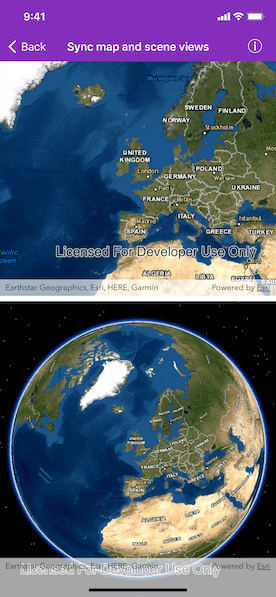Keep the view points of two views (e.g. map view and scene view) synchronized with each other.

Use case
You might need to synchronize AGSGeoView viewpoints if you had two map views in one application - a main map and an inset. An inset map view could display all the layers at their full extent and contain a hollow rectangular graphic that represents the visible extent of the main map view. As you zoom or pan in the main map view, the extent graphic in the inset map would adjust accordingly.
How to use the sample
Interact with the map view or scene view by zooming or panning. The other map view or scene view will automatically focus on the same viewpoint.
How it works
- Add
viewpointChangedHandlers to both anAGSMapViewand anAGSSceneView. - Track the user's
AGSViewpointand set that to each of theAGSGeoViews' viewpoints usingAGSGeoView.setViewpoint(_:)
Relevant API
- AGSGeoView
- AGSMapView
- AGSSceneView
About the data
This application provides two different perspectives of the imagery basemap. A 2D map view as well as a 3D scene view, displayed side by side.
Tags
3D, automatic refresh, event, event handler, events, extent, interaction, interactions, pan, sync, synchronize, zoom
Sample Code
//
// Copyright 2018 Esri.
//
// Licensed under the Apache License, Version 2.0 (the "License");
// you may not use this file except in compliance with the License.
// You may obtain a copy of the License at
//
// http://www.apache.org/licenses/LICENSE-2.0
//
// Unless required by applicable law or agreed to in writing, software
// distributed under the License is distributed on an "AS IS" BASIS,
// WITHOUT WARRANTIES OR CONDITIONS OF ANY KIND, either express or implied.
// See the License for the specific language governing permissions and
// limitations under the License.
//
import UIKit
import ArcGIS
class SyncMapAndSceneViewsViewController: UIViewController {
/// The map view to display the map.
@IBOutlet private weak var mapView: AGSMapView!
/// The scene view to display the scene.
@IBOutlet private weak var sceneView: AGSSceneView!
override func viewDidLoad() {
super.viewDidLoad()
// add the source code button item to the right of navigation bar
(navigationItem.rightBarButtonItem as! SourceCodeBarButtonItem).filenames = ["SyncMapAndSceneViewsViewController"]
// add a map with labeled imagery to the map view
mapView.map = AGSMap(basemapStyle: .arcGISImagery)
// add a scene with labeled imagery to the scene view
sceneView.scene = AGSScene(basemapStyle: .arcGISImagery)
// add handlers to each view to receive viewpoint change events
mapView.viewpointChangedHandler = { [weak self] in
guard let self = self else {
return
}
self.synchronizeViewpoints(to: self.mapView)
}
sceneView.viewpointChangedHandler = { [weak self] in
guard let self = self else {
return
}
self.synchronizeViewpoints(to: self.sceneView)
}
}
/// Sets the viewpoint of all views to that of the sender.
private func synchronizeViewpoints(to sender: AGSGeoView) {
// Check that the user is actively navigating this view, since viewpoint
// change events are also called on `setViewpoint(_:)`. This check prevents
// a feedback loop.
guard sender.isNavigating,
/// The viewpoint of the view currently being navigated.
let senderViewpoint = sender.currentViewpoint(with: .centerAndScale) else {
return
}
/// An array of views that we want to synchronize.
let allGeoViews = [mapView, sceneView]
// loop through all the views we want to sync and set their viewpoints
for geoView in allGeoViews {
// if this view isn't the sender
if geoView != sender {
// set the viewpoint to match that of the sender
geoView?.setViewpoint(senderViewpoint)
}
}
}
}